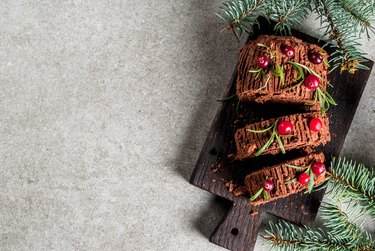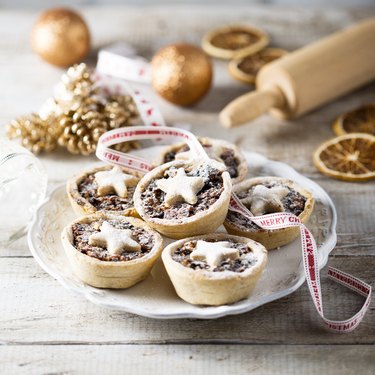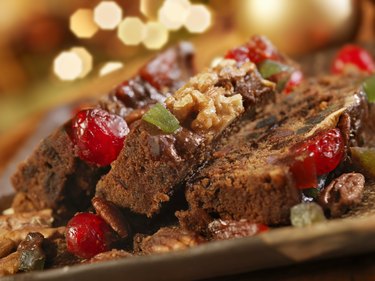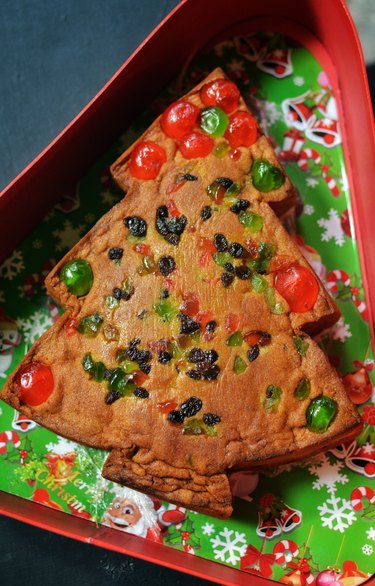
There's a reason Charles Dickens focuses so much on food and drink in A Christmas Carol: The things we serve our family and guests go a long way toward creating that holiday spirit. This is true for main course meals and special holiday treats alike—which is why it's frustrating when recipes don't work out and downright stressful if your guests are arriving any minute.
These holiday dessert disasters include everything from crumbly cookie dough ("Why isn't it holding together?") to a leaden fruitcake. Whatever the disaster, it can be downright dispiriting. The good news is that these sweet treats can often be fixed on the fly or at least repurposed into something you'll be proud to serve. If your dish is quickly veering off course, don't melt down. Take a look at our holiday dessert rescue guide and get that tasty treat back on track!
Video of the Day
Video of the Day
Homemade cookies—sugar cookies, gingerbread cookies, shortbread cookies and many, many more—are among the most iconic holiday treats. There are several ways cookies can go wrong, especially if you're trying a new recipe. If you catch these snags before you bake the rest of your batch, though, your cookies can often still be salvaged. Here are the most common issues and how to resolve them:

Dry cookie dough can happen in a couple of ways. In shortbread cookies or other butter-based recipes without liquid ingredients, dry dough might mean you've measured slightly too much flour or not enough butter. Also, butter can vary in its moisture content. Try holding a ball of dough in your hand for a moment to warm it, then compress it to see if it holds together. If it does, you need to work your dough a bit more to soften the butter. If not, add another tablespoon or two of butter and work it through the dough before rolling and cutting your cookies again.
In cookies that do contain eggs or other liquids, having too little liquid is sometimes the culprit. In that case, fix dry dough by adding another spoonful or two of whichever liquid your recipe uses (usually milk or beaten egg) and gently incorporating it into the dough. You'll need a light hand, because overmixing a dough that has liquids in it can bring out the gluten and make your cookies tough.
Tip
Unlike granulated sugar, flour is easy to compress while measuring. That means you’ll be using more flour than you think, which can really mess with your recipes. Many cookbooks tell you to measure a cup of flour not by scooping it right from the bag but by spooning flour into the cup and then leveling it by swiping across the top with the back of a knife. This ensures that the flour won’t be too compressed.
Better yet, bake the way the professionals do: Get yourself a good kitchen scale and look for recipes that measure ingredients by weight rather than cups.

Many cookies, like the chocolate chip variety, are supposed to spread as they bake. If this doesn't happen, your dough might be too dry. (See above for solutions.) It could also mean that your dough is too cold or that the recipe called for room temperature ingredients but you skipped that step. Leaving the dough to warm up for a little while before baking can help, but the simplest fix is often to simply flatten your dough balls manually before placing cookies in the oven. Cut or tear a piece of parchment paper about 3 or 4 in. square and find a glass, mug or small saucepan with a perfectly flat bottom. Place the parchment paper over each dough ball in turn, then gently flatten to even rounds. They'll warm up much more quickly in the oven and should spread properly as they bake.
When cookies overspread, there are multiple explanations. Your dough might be too soft and need a bit more flour or (for delicate recipes such as shortbreads and spritz cookies) some chilling time in the fridge. Did the cookie recipe call for an ungreased sheet pan? If so, baking on parchment or a silicone mat will make them spread too much (the recipe counts on the dough sticking—just lightly—to the pan, which limits spread). In fact, baking a spreading-type cookie on a silicone mat is usually a bad idea. Parchment paper is preferred if your recipe allows for it.
If your cookies are tough or hard instead of delicate and crisp, it typically means there's been too much gluten development in the dough. (This is good for bread, but bad for cookies and cakes.) Overmixing after you've added wet ingredients to dry ingredients will have this result, as will using plain old all-purpose flour when your recipe calls for cake or pastry flour. It's a tough one to fix after the fact, but letting dough rest in the refrigerator for an hour will help relax the gluten. Be careful to handle the dough as little as possible afterward: This is one time you probably don't want to reroll the scraps to make new cookies. (Bake them as is for a "baker's treat" or a snack to give the kids.)

It's often possible to fix the rest of the batch (or the next batch, as the case may be), but that still leaves your problematic first pan of flawed cookies. There are several uses for these, as long as they're not burned or bad-tasting. (Baked goods are pretty flexible in that respect.) Soft cookies can be packed into the bottom of a baking pan, for example, and used as the base for improvised bar cookies. Alternatively, broken-up cookies can be spread out in a pan and covered in melted chocolate to make "cookie bark," which should go over swimmingly at your next gathering.
Hard cookies can be pulsed in the food processor and used in place of graham cracker crumbs for crumb crusts. You can break them up and layer with custard and whipped cream in a riff on trifle, or do the same thing in individual serving glasses and call it a parfait. Hard cookies will also work if you simply spread them with whipped cream and line them up to make a cylindrical loaf, covering the outside with cream, as well. After a few hours (or overnight) in the fridge, you'll be able to slice easily and serve like cake.
If you have more cookies than you can use immediately, keep them in an airtight container for next time (or for nibbling between visitors).
Problem #2: Yule Log Cake (Bûche de Noël)
Another iconic seasonal dessert is the Yule log, or bûche de Noël, as the French call it. It's a chocolate spongecake that's rolled twice, jelly-roll fashion—once while still hot from the oven and a second time around a whipped-cream filling after cooling—then decorated to resemble an actual log. Here are a few problems you might encounter while making a Yule log.

1. "The cake is dense and flat."
Sponge cakes get their rise from beaten egg whites. While folding dry ingredients into whites, it's (sadly) very easy to squish air from the delicate foam, leaving you with a cake that doesn't rise well. Buy yourself some wiggle room by choosing a recipe that includes a bit of baking powder, which helps compensate for any loss of lift from the egg whites. Aside from that, the only thing you can do is practice folding ingredients into egg whites. It helps to stir in 1/4 to 1/3 of the whites to loosen and lighten the batter before folding in the rest. The correct motion scoops batter from the bottom of the bowl over top of the egg whites (rather than a stirring motion). Your best tool for the job is a soft silicone spatula or "spoonula."
2. "The cake is dry and crumbly."
This will happen if you bake your cake for too long or you've used a larger pan than the recipe calls for (yielding a thin cake, which bakes faster). Using the proper pan and checking it every few minutes will help. You can also improve a cake's texture and moisture—and therefore the likelihood of rolling it successfully—by using a chiffon cake recipe rather than a regular sponge cake. Chiffon cakes add a bit of fat in the form of vegetable oil, melted butter or margarine, which gives a softer and moister result.
3. "The cake cracked during the first rolling."
The plan with a rolled cake is to have a clean kitchen towel waiting when it leaves the oven. Just flip the pan right onto the towel and lift it off, leaving the cake behind. It might feel just wrong to handle your cake the second it comes out of the oven, but the more you let the cake cool, the greater the likelihood it's going to crack. Don't worry about peeling off the parchment yet (which is just asking for trouble). Instead, flip the end of the towel over the end of the cake and use the towel itself to make that first, tight inner roll. Then keep rolling: You'll have layers of cake, parchment and towel, but that's fine. Don't sweat making the rest of the roll too tight. This is often when, and why, it cracks.
If your cake cracked at this stage, don't panic! You can fill in the gap with icing later on while decorating. In a worst-case scenario, you can cut a thin strip from the end of the cake before rerolling and then use that to fill an especially large crack. Really, who's going to complain about a little extra icing in their slice?

4. "The cake cracked during the second rolling."
After the cake cools in its rolled position, you'll unroll it (still on its towel) and remove the parchment. Spread it with filling and roll it up again, still using the towel to help nudge the cake into the right shape. If it cracks at this point, it's usually because you've put on too much filling (aim for a layer that's 1/2 to 2/3 the thickness of the cake itself) or haven't spread it evenly. You can scrape away a bit of filling from the remainder of the cake and continue rolling (a crack at the beginning of the roll will be hidden inside) or continue and patch the crack with icing later.
5. "The filling squished out."
Again, this often happens because you've simply used too much filling (or the recipe makes more filling than you really need). If your filling is plain whipped cream, it might not have been whipped stiffly enough or you might need to thicken and stabilize it (icing sugar and cocoa can both help with that). You can also try a mixture of whipped cream and prepared custard or pudding, which will be thicker and sturdier.
You could unroll and reroll the cake with a thicker filling if you wish, but that's messy. A better option is almost certainly to wipe or scrape away the excess and call it good. The cake might not be as impressive when sliced, but as long as there's a clearly visible layer of filling, you're still in good shape.

How to repurpose a failed yule log:
If your yule log fell apart completely during rolling or if you decided to scrap your first attempt and start over, you're left with a (sometimes literal) pile of chocolate cake. As problems go, it's a good one to have. You can make cake pops (there's a seasonal variation here) or pulse the cake to crumbs in your food processor for making rum or bourbon balls. Alternatively, take the traditional route, layer cake pieces with custard and whipped cream and call it trifle.
Problem #3: Mincemeat Tarts or Pies
Mincemeat, like fruitcake, is a polarizing holiday treat. Some love mince tarts, but there are enough raisin-haters around that you might find yourself in the minority. Also, note that the "meat" part is literal in some traditional recipes, so read the ingredients list (whether store-bought or homemade) if you need a for-sure vegetarian or vegan filling. Here are some common problems and how to tackle them:

1. "The mincemeat is too dry."
If you're making your own mincemeat filling, you might find that it's drier than intended. That's because most recipes include a mixture of both fresh and dried fruit, and dried fruits can vary widely in their "dryness." This means they might absorb more moisture than the recipe creator anticipated, leaving your filling a bit gummy and not-so-appealing. Add moisture with a few extra ingredients such as apple cider, another splash of the rum, brandy or other spirits the recipe calls for, or even plain old water. Proper mincemeat needs richness from fat as well, which helps fix the perception of dryness. Traditional recipes use suet, but a small amount of melted butter, vegetable oil or coconut oil would work just as well.
2. "The mincemeat is too wet."
The opposite problem can also occur. Either your fresh fruit has released too much moisture or your dried fruit hasn't absorbed enough. Overly wet mincemeat might also mean you were heavy-handed with the spirits your recipe called for. Put the whole batch in a low oven (250°F or thereabouts) until the excess has evaporated or strain the excess moisture into a small saucepan, simmer it until it has reduced to a syrupy consistency and stir it back in.
Tip
Let your homemade mincemeat cool thoroughly before making pies or tarts. Putting warm filling into a pie crust means it will bake up soggy and limp on the bottom.

3. "My pie crust is tough."
The ideal time to realize this is before you bake your pie. Unfortunately, that's not usually how it works out and there are several reasons for a tough pie crust. For example, you might have over-handled your dough. If you knead it like bread, you'll end up with lots of gluten development and a chewy, leathery texture. The ideal dough is slightly crumbly and just barely holds together. Most mincemeat pie recipes call for a relatively "short" crust, meaning one with a high fat ratio. This makes a richer, softer dough (like a shortbread without the sugar), so using enough fat is important.
How to repurpose failed mincemeat pies:
If your crust has let you down, one obvious option is to fall back on store-bought pie crust or tart shells. Simply scoop the filling from your pie, moisten it if necessary (see above) and use it to fill new shells. Leftover or recovered filling makes delicious cookies, either sandwiched between two rounds of sugar cookie or shortbread dough or kneaded right in. You can also add it to blondies, encase it in chocolate to make "bark" and use it to stuff sweet buns—or roll it up in sweet yeast dough, cinnamon bun-style. For a chillier treat, incorporate it into homemade ice cream.
Problem #4: Fruitcake
You knew we'd get here in the end, right? Fruitcake is arguably the most iconic holiday dessert of all but also one of the most polarizing. While some love the old-school combination of spices, densely rich cake and dried fruit, others find it as old-fashioned and off-putting as shag carpeting. If you've opted to make your own instead of buying one from the supermarket, good for you! It's definitely a project—but well worth it if the result is a good fruitcake. If yours falls short, there are a couple of things that might have gone wrong along the way.

1. "The fruitcake is too dry."
A proper fruitcake is rich and moist. If yours doesn't have enough moisture, it's often because you haven't soaked your dried fruit long enough. Dry ingredients will soak up the moisture from your cake if they aren't fully hydrated, so this isn't the step to skimp on. If you haven't yet baked the remaining loaves, add more liquid to the batter to compensate. If you have baked them but still have time for tweaks, poke holes into the cakes with a skewer and drizzle with room temperature simple syrup (equal parts water and sugar boiled together, then cooled). It's a pastry chef's trick for moistening dry cakes, and it works well.
Tip
Add vanilla, spirits or spices to your simple syrup for an added hit of flavor.
2. "The fruitcake is soggy and dense."
Again, every problem has an opposite. The culprit here might have been a poorly written recipe or a mistake while measuring ingredients, but it's just as likely to be—again—the variability of dried fruit. If the fruit doesn't absorb enough moisture and you dump it alongside soaking liquid into your cake, it might turn sodden. If you haven't baked off the rest of the batter, add a bit more flour to balance wet and dry ingredients. If you have already baked the cake, there's not a lot you can do except find ways to repurpose.

3. "The fruitcake just doesn’t taste very good."
You might find, after going to all this trouble, that—although your cake turned out okay—you just aren't keen on its flavor. There are a couple of things you can try before you write it off (or gift it to an unsuspecting relative). One option is to poke the cake with a skewer and drizzle it with an appropriately flavored simple syrup (warm spices, rum or bourbon perhaps). Another idea is to top the cake with a layer of marzipan or another form of icing.
For future fruitcakes, look back at the dessert's history. Fruitcake's heavy use of spices, spirits and preserved fruits—the richest and costliest ingredients, centuries ago—was meant to showcase the very best things a baker could afford. Mediocre ingredients make for mediocre fruitcake, so buy fresh spices before you start your holiday baking (you'll thank us!) and splurge on high-quality preserved fruit rather than low-cost, low-quality, artificially colored stuff at the supermarket. It makes a world of difference.

How to repurpose failed fruitcake:
Fruitcake requires a significant investment in time and ingredients, so you definitely don't want to let it go to waste. One option is to dry cut-up fruitcake in a low oven and make thumb-sized bars to eat as biscotti, thinly shaved slices to serve as crisps with condiments or strong cheese, or even cubes to serve as flavorful croutons. Use dry fruitcake to make French toast or an overnight breakfast casserole, or—best of all—use it in a deluxe bread pudding with a custard or brandy-based sauce. Yum!
Don't let these common holiday dessert disasters get you down. There's almost always a solution—and, if not, options for repurposing are plentiful. Better yet, you'll have the knowledge you need to avoid future baking mishaps.
